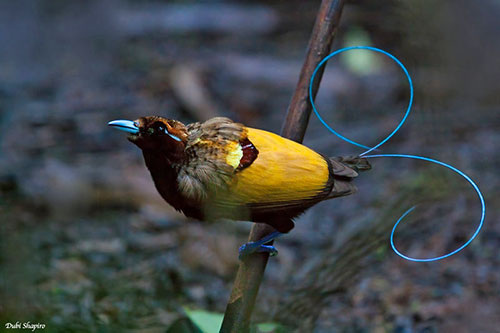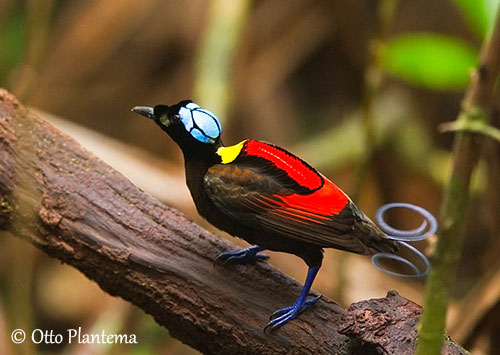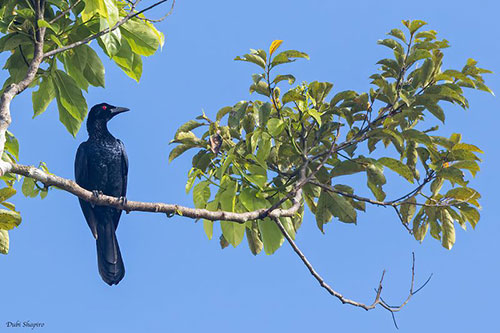
TO BE CONTINUED... Second part Range, habitat, feeding behaviour, general habits, flight and sounds
Text by Nicole Bouglouan
Photographers:
Jean Michel Fenerole
Photos d’Oiseaux
Otto Plantema
Trips around the world
Dubi Shapiro
Dubi Shapiro Photo Galleries
Illustrations:
Daniel Giraud Elliot (1835 – 1915)
Richard Bowdler Sharpe (1847-1909)
John Gould (1804-1881)
These images and the text are subject to copyright and cannot be used without express authorization from the owners. Legal issues
Sources:
HANDBOOK OF THE BIRDS OF THE WORLD Vol 14 by Josep del Hoyo-Andrew Elliot-David Christie - Lynx Edicions – ISBN: 9788496553507
Birds of Paradise and Bowerbirds De Phil Gregory – Editeur: Bloomsbury Publishing, 2020 – ISBN: 1472975847, 9781472975843 – 416 pages
Les Oiseaux de paradis – Histoire Naturelle et photographies - par Michel Ottaviani - Editions Prin, France – ISBN : 2-909136-40-X
Birds of New Guinea: Second Edition De Thane K. Pratt, Bruce M. Beehler – Editeur: Princeton University Press, 2014 – ISBN: 0691095639, 9780691095639 – 528 pages
Birds of New Guinea: Distribution, Taxonomy, and Systematics De Bruce M. Beehler, Thane K. Pratt – Editeur: Princeton University Press, 2016 – ISBN: 069116424X, 9780691164243 – 672 pages
Book of Curious Birds De Jennifer Cossins – Editeur: Hachette UK, 2021 – ISBN: 073442048X, 9780734420480 – 64 pages
Astonishing Animals: Extraordinary Creatures and the Fantastic Worlds They ... De Tim Flannery – Editeur: Open Road + Grove/Atlantic, 2012 – ISBN: 0802194176, 9780802194176 – 192 pages
Bird: The Definitive Visual Guide De DK – Editeur: Dorling Kindersley Ltd, 2022 – ISBN: 0241596319, 9780241596319 – 512 pages
Birds of the World publié par Jason A. Mobley – Editeur: Marshall Cavendish, 2008 – ISBN: 0761477756, 9780761477754 – 846 pages
The (un)reasonable beauty: What factors shaped the evolution of Paradisaeidae?
CREAGUS@Monterey Bay (Don Roberson)
Fatbirder - The World’s Richest Information Resource about Birds for Birders
Wikipedia, the free encyclopaedia
BIRDS OF PARADISE – Facts and details
Bird of Paradise Symbolism & Meaning
FAMILY PARADISAEIDAE (First part)
Birds-of-paradise, Standardwing, Riflebird, Manucode, Parotia, Paradigalla, Paradise-crow, Crow, Lophorina, Sicklebill and Astrapia
The members of the family Paradisaeidae in the order Passeriformes are among the most beautiful birds of the world with probably the most amazing courtship displays. They are endemic of Papua New Guinea and nearby islands, and a few species can be found in NE Australia.
They frequent the tropical rainforests at various elevations. Their diet includes insects, spiders, frogs, and especially fruits.
The Paradisaeidae males are known for their outstanding plumages, iridescent colours and elongated ornamental plumes extending from bill, head, wings and tail. The females have much duller plumage with cryptic pattern, as they have to build and tend the nest without any help from the male. In these flamboyant species, the males are usually polygamous and breed with several females each season.
Their courtship displays are wonderful, with the bird moving rhythmically while the filamentous plumes and the elongated feathers follow the waving movement. Each coloured part of the body is exposed and enhanced by adapted postures, fluffed or stiff plumage or vibrating plumes, depending on the phase of the display. The male may appear like a rainbow moving on a naked branch previously defoliated to stay focused on the displays.
However, in some species, both male and female show similar, fairly drab plumage. These species are monogamous.
The birds of paradise are closely related to the crows of the family Corvidae. Anatomically, they are typical of the oscine passerines (The oscines or “songbirds” refers to distinctive morphology of the highly specialized syrinx of several species such as larks, shrikes, finches, orioles, and crows) and are generally crow-like in their average size, shape, strength, behaviour and vocalizations.
Several species resemble crows, showing sturdy bodies, stout bills, strong legs and feet.
Family presentation
The family Paradisaeidae currently includes 17 genera and 45 species in which we can find two well defined lineages.
The first lineage comprises the manucodes of genus Manucodia, along with the species of genus Lycocorax.
This lineage is distinctive and it could constitute a valid subfamily. It is well defined by a range of characters, and especially the plumage and the tracheal morphology for sound production. There are five species of genus Manucodia, and two species of genus Lycocorax.

Glossy-mantled Manucode
Manucodia ater
The Manucodia species are medium-sized birds, with black-glossed purple and green plumage. They are found in the lowland forests of New Guinea and nearby islands.
These species are monogamous and male and female have similar appearance but the females are usually smaller.
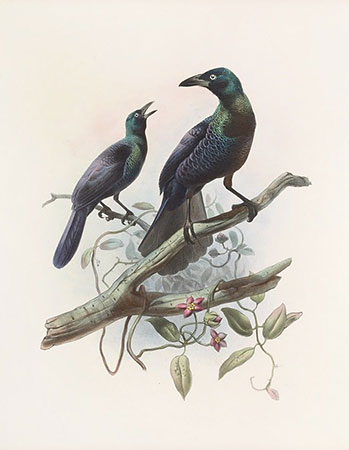
Crinkle-collared Manucode
Manucodia chalybatus
Daniel Giraud Elliot (1835 – 1915)
The Trumpet Manucode, formerly a member of the genus Manucodia, is now placed in the monotypic genus Phonygrammus. It is sympatric with each species of Manucodia at different localities, but no cases of hybridization recorded.
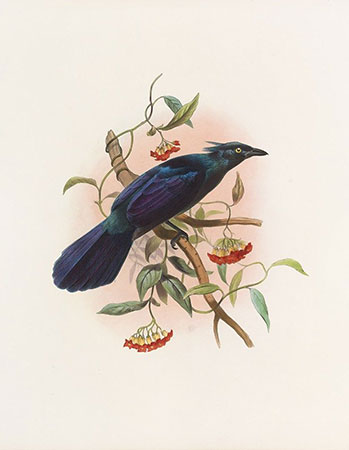
Trumpet Manucode
Phonygammus keraudrenii
Daniel Giraud Elliot (1835 – 1915)
The two species of genus Lycocorax, the Halmahera Paradise Crow and the Obi Paradise Crow, have a crow-like appearance except the deep red eyes. Lycocorax pyrrhopterus was originally described as a crow. Male and female are similar and they are monogamous. They live in the lowlands of the Moluccas Islands (Indonesia).
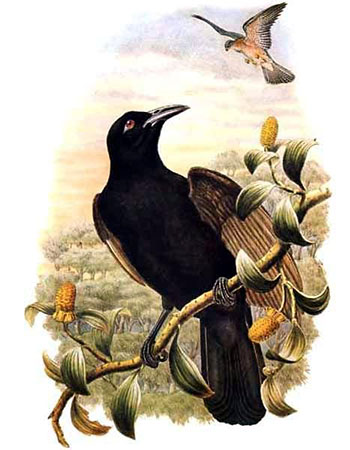
Halmahera Paradise-crow
Lycocorax pyrrhopterus
Richard Bowdler Sharpe (1847-1909)
The second lineage contains the species known as “plumed paradisaeinae birds” and there are 38 species of various genera.
The two Paradigalla species remain little known. They can be found in NW and Central Range of New Guinea. Their nesting habits are like those of typical Paradisaeinae birds-of-paradise and the males are assumed to be polygynous. The black plumage of both male and female and the egg morphology make them close to Manucodia, although habits, plumage, body and bill morphology appear closest to Astrapia. The bill is small and slim.
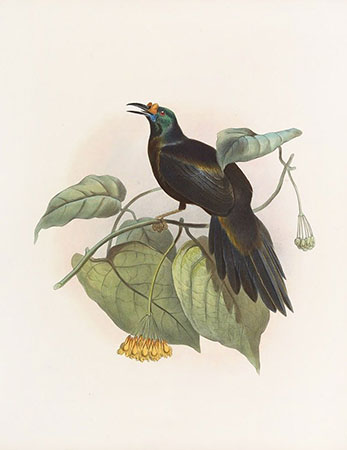
Long-tailed Paradigalla
Paradigalla carunculata
Daniel Giraud Elliot (1835 – 1915)
The genus Astrapia contains five species, endemic to New Guinea. It is linked to the basal Paradisaeinae taxa with the mainly black but iridescent plumage and long tail, but the erectile head and mantle feathering, the barred underparts of the females and the egg morphology link them to the plumed lineage.
The Ribbon-tailed Astrapia - Astrapia mayeri, shows very well this option with erectile feathering on both male’s head and mantle, and female’s barred underparts. On the other hand, the black plumage, iridescent head and breast feathering may suggest a link to the riflebirds of genus Ptiloris.
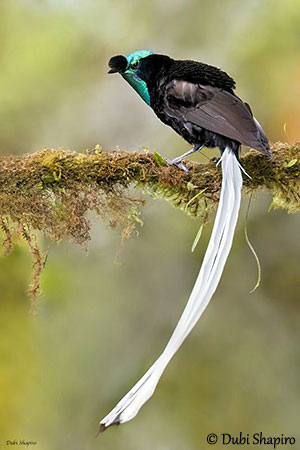
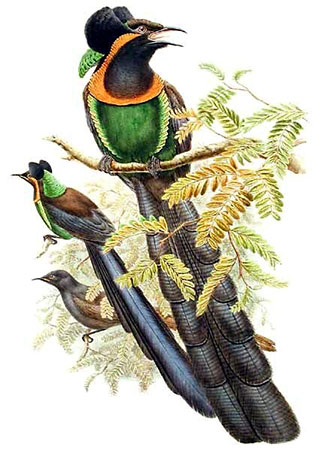
Arfak Astrapia
Astrapia nigra
Richard Bowdler Sharpe (1847-1909)
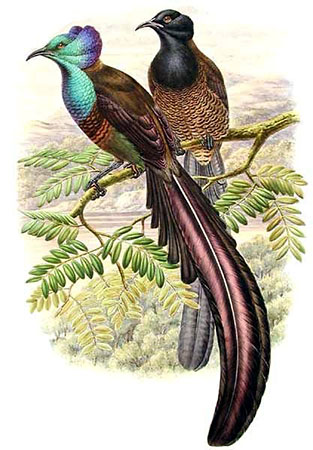
Princess Stephanie's Astrapia
Astrapia stephaniae
Richard Bowdler Sharpe (1847-1909)
But the 25 plumed species seem to be the result of a single radiation.
We can find four clades defined by the morphology.
The “flagbirds” of genera Pteridophora and Parotia in which the males have spectacular erectile occipital plumes, velvety-black dorsal plumage, and iridescent throat or breast patch.
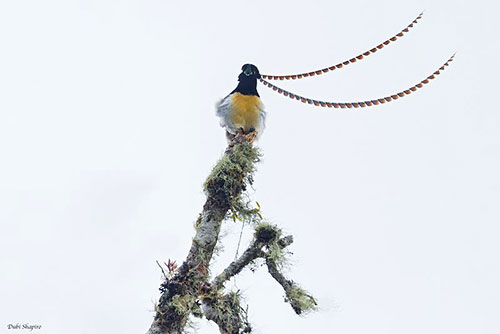
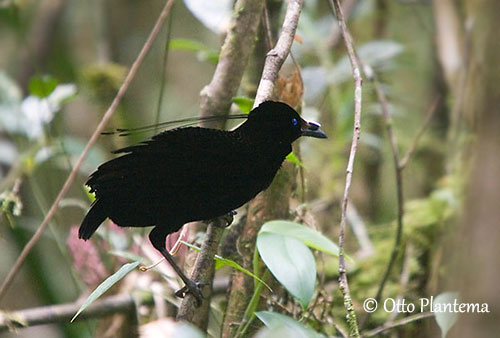
Lawes's Parotia
Parotia lawesii
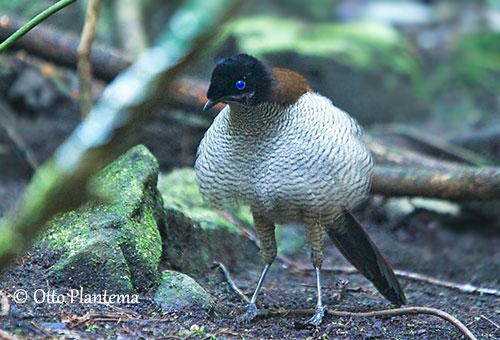
Western Parotia
Parotia sefilata
Young male displaying
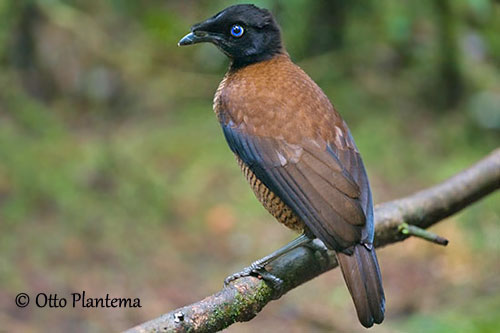
Lawes's Parotia
Parotia lawesii
FEMALE
The riflebirds of genera Ptiloris and Lophorina, with males showing mainly velvety-black plumage and striking, large, iridescent blue breast shield.
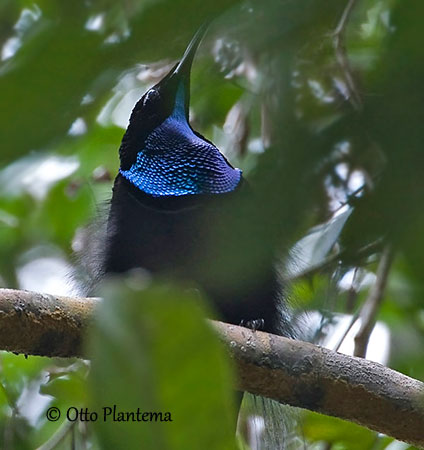
Magnificent Riflebird
Ptiloris magnificus
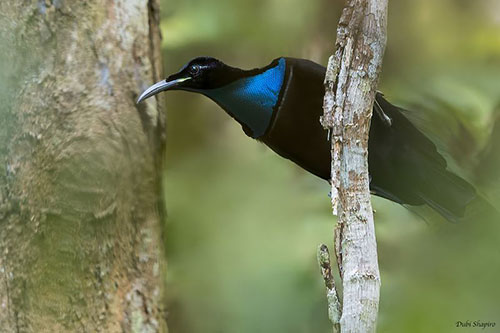
Growling Riflebird
Ptiloris intercedens
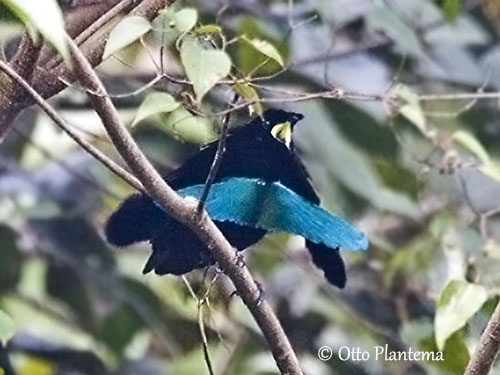
Greater Lophorina
Lophorina superba
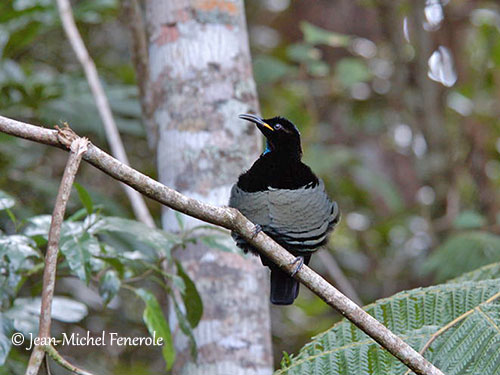
Victoria's Riflebird
Ptiloris victoriae
The sicklebills of genera Epimachus show marked sexual dimorphism, males with very long tails, iridescent crown and mantle feathering, while the sicklebills of genus Drepanornis have much shorter tails, less marked sexual dimorphism and bare facial skin. Both sexes have long, sickle-shaped bills.
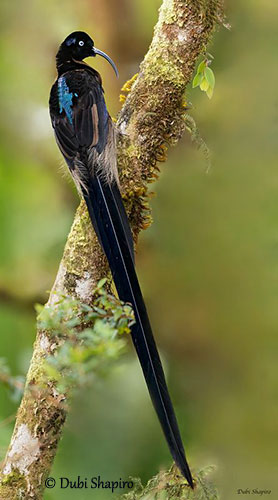
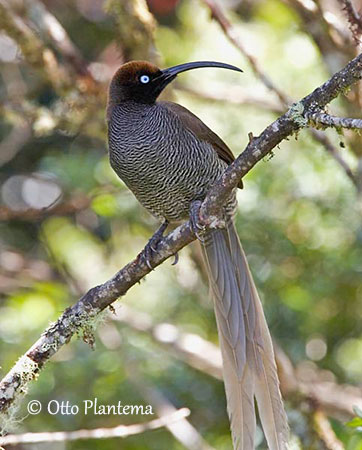
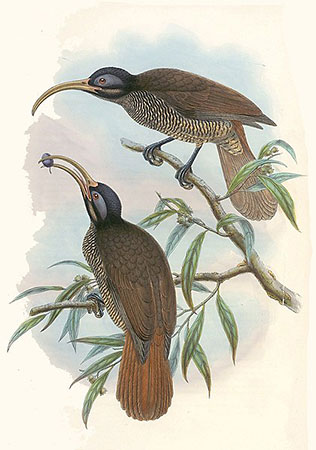
Pale-billed Sicklebill
Drepanornis bruijnii
Pair
John Gould (1804-1881)
And finally the sickletails of genus Cicinnurus together with the typical plumed species of genera Semioptera, Seleucidis and Paradisaea. Adult males have iridescent green and brilliant red and/or yellow areas in their plumages.
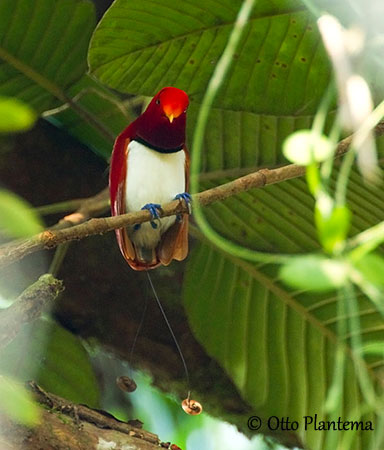
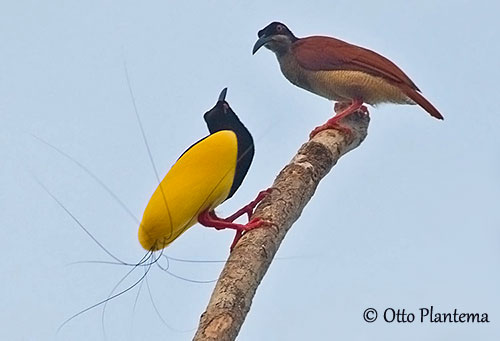
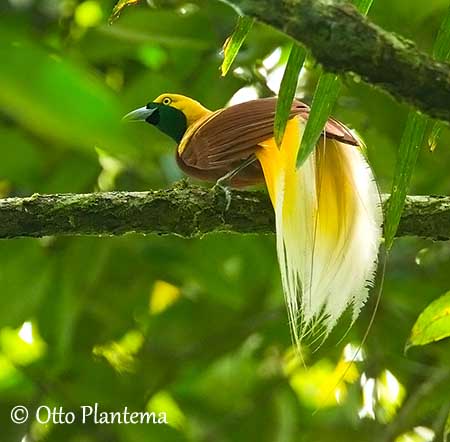
Today, the genus Cicinnurus includes a single species, the King Bird-of-paradise - Cicinnurus regius (C. regius).
The two other species formerly in this genus, the Magnificent Bird-of-paradise - Diphyllodes magnificus and the Wilson's Bird-of-paradise - Diphyllodes respublica are now in the genus Diphyllodes.
These three species have the central tail feathers modified into recurved wires, iridescent green underparts, red dorsal plumes and blue legs and feet.
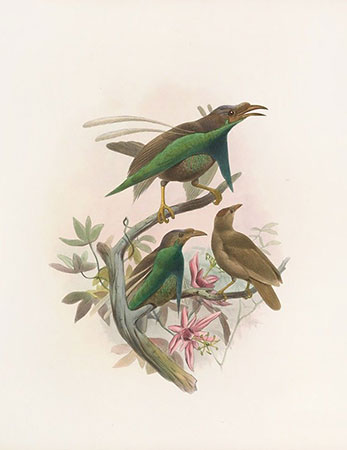
Standardwing
Semioptera wallacii
Daniel Giraud Elliot (1835 – 1915)
The Twelve-wired bird-of-paradise - Seleucidis melanoleucus of genus Seleucidis shows some features of two other sublineages. The black plumage of the adult male, the long decurved bill and the heavily barred female, link it to the riflebirds, whereas the filamentous yellow flank plumes, pale legs and eyes, link it to the Paradisaea lineage.
The Paradisaea species show filamentous elongated flank plumes and elongated wire-like or tape-like central rectrices. This lineage comprises six species of “true” plumed birds.
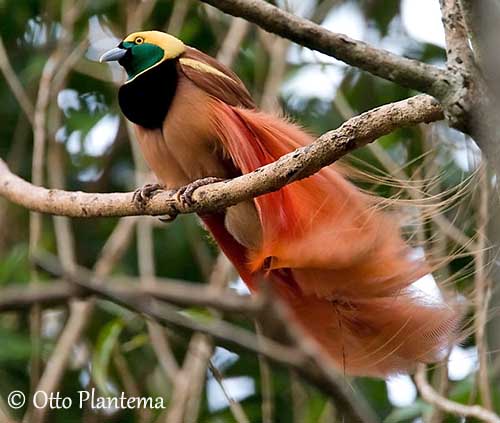
The Blue Bird-of-paradise - Paradisornis rudolphi is now placed in the genus Paradisornis.
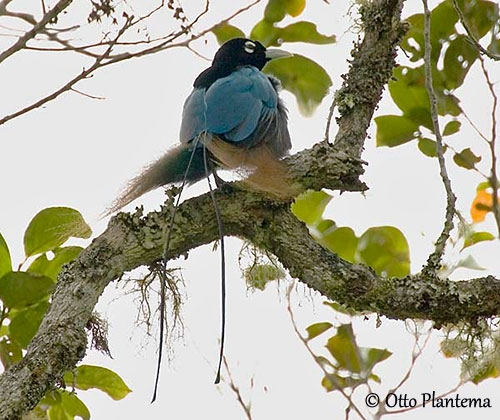
The birds of paradise deserve to be known first for their wonderful appearance (even the black species with their deep red eyes show both beauty and elegance) but also for their amazing courtship displays, accompanied by a wide variety of sounds.
We will therefore discover them in the following pages, through their feeding, nuptial and reproductive behaviour and habits.
Unfortunately, this beauty attracts humans who do not hesitate to take males to use their feathers for ornamental purposes. Several species are threatened by heavy hunting pressure, but also by habitat loss.
